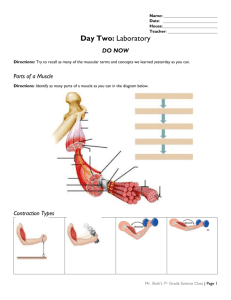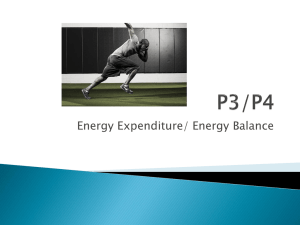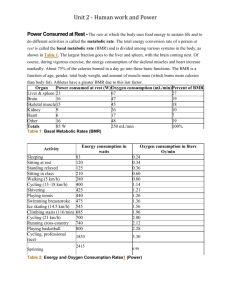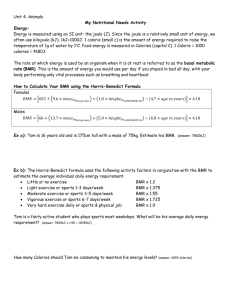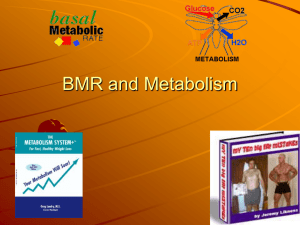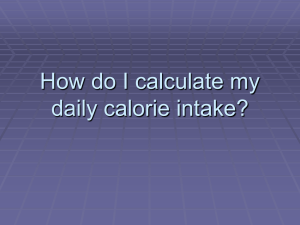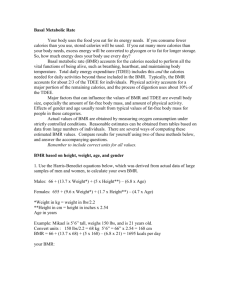Muscular System Worksheet: Disorders, BMR, & Calories
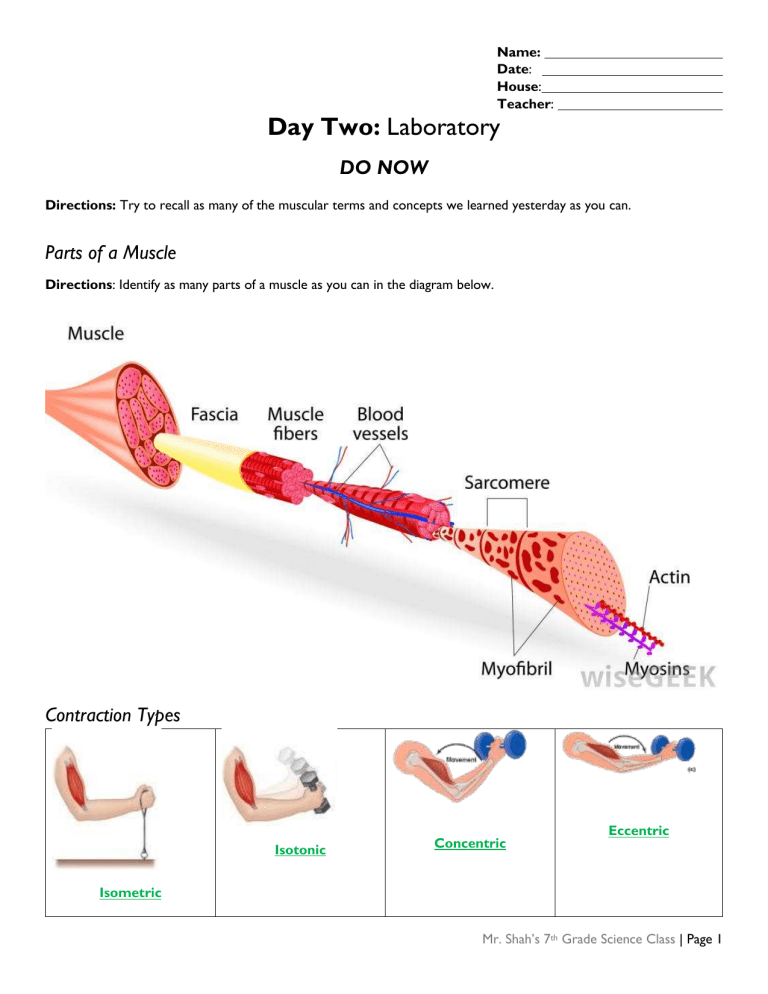
Name:
Date:
House:
Teacher:
Day Two: Laboratory
DO NOW
Directions: Try to recall as many of the muscular terms and concepts we learned yesterday as you can.
Parts of a Muscle
Directions: Identify as many parts of a muscle as you can in the diagram below.
Contraction Types
Isometric
Isotonic
Concentric
Eccentric
Mr. Shah’s 7 th Grade Science Class | Page 1
I DO: Muscular Disorders
Directions: Organize notes about the most common disorders and diseases of the muscular system.
Muscular Dystrophy
Classification
Progressive muscle degenerative disease
Signs and Symptoms
Muscle loss, poor balance, drooping eyelids, atrophy, scoliosis, inability to walk, waddling gait
Diagnosis
Muscle biopsy, electromyography,
DNA analysis, and physical examination
Treatment
Preventable?
None
Curable?
None
Manageable?
Physical therapy
Occupational therapy
Orthopedic tools
Myasthenia Gravis
Classification
Autoimmune neuromuscular disease where antibodies attack normal body proteins
Signs and Symptoms
Quick to tire, drooping eyelids, slurred speech, weakness during activity that returns during inactivity
Diagnosis
Difficult to diagnose.
Physical examination, symptoms in infancy or childhood, blood tests for antibodies
Treatment
Preventable?
None
Curable?
None
Manageable?
Medication or surgery
Physical therapy
Myotonia Congenita
Classification
Genetic neuromuscular disease
Signs and Symptoms
Failure of contracted muscles to relax, especially during periods of rest
Diagnosis
Genetic history
Difficulty swallowing or closing eyes
Treatment
Preventable?
None
Curable?
None
Manageable?
Only in extreme cases
Anticonvulsant drugs
Physical therapy
Tendonitis
Classification
Inflammatory disorder of a tendon, generally after acute injury
Signs and Symptoms
Aches, pains, joint stiffness, burning sensation, swelling
Diagnosis
Symptoms present after an acute injury and/or stressful situations
Treatment
Preventable?
Prevention of injury
Curable?
Rest and time
Manageable?
Non-steroidal antiinflammatory drugs
Laser therapy
Mr. Shah’s 7 th Grade Science Class | Page 2
WE DO: Basal Metabolic Rate
Basal Metabolic Rate (BMR) is used to measure how much energy your body needs and uses to carry out its basic functions at rest. From pumping blood, to breathing, to sending signals in the nervous system, to fighting diseases, to muscle movement, mitochondria are working hard to provide the energy needed to keep you alive and operational. This energy is measured in terms of calories, and when used, can be restored by eating food.
Once BMR is calculated, we may still need additional calories based on our daily needs. Many factors can influence BMR:
Genetics
Gender
Age
Muscle mass
Body temperature
Exercise
Directions: Follow the steps below to calculate your own BMR.
1.
Define the following variables according to your own measurements: a = weight in pounds b = height in inches c = age
2.
Plug these variables into the Harris Benedict Equation and solve to calculate your BMR.
BMR = 66 + (6.23 x a
) + (12.7 x b
) – (6.8 x c
)
My BMR =
Mr. Shah’s 7 th Grade Science Class | Page 3
Activity Level
Sedentary
Light Exercise (1-3 days/week)
Moderate Exercise (3-5 days/week)
Intense Exercise (6-7 days/week)
Very Intense Exercise (2/day)
YOU DO: Calorie Counting
Daily Calories Needed
BMR x 1.2
BMR x 1.375
BMR x 1.55
BMR x 1.725
BMR x 1.9
In the space below, calculate your daily calories needed based on your activity level and BMR.
Daily Calories Needed: _____________
1.
Assume you eat three meals a day, plus a few snacks in between. How many calories would you budget for each of these meals? Remember, these must add up to your Daily Calories Needed.
Calories for Breakfast Calories for Lunch Calories for Dinner Calories for Snacks
The table to the left shows the number of calories in many common fast food items. Which of these food items would fit into your caloric budget?
Mr. Shah’s 7 th Grade Science Class | Page 4
Name:
Date:
House:
Teacher:
EXIT TICKET
Directions: Jill Rothman, a 26-year-old gymnastics instructor, presents with complaints of muscle weakness in her face that comes and goes, but has been getting worse over the past two months. Most notably, she complains that her "jaw gets tired" as she chews and that swallowing has become difficult. She also notes diplopia ("double vision") which seems to come on late in the evening, particularly after reading for a few minutes. At work, it has become increasingly difficult to "spot" her gymnasts during acrobatic moves because of upper arm weakness. On physical examination, she has notable ptosis ("drooping") of both eyelids after repeated blinking exercises. When smiling, she appears to be snarling.
Diagnose the patient with one of the muscle disorders below.
Muscular Dystrophy Myasthenia Gravis Myotonia Congenita Tendonitis
Then, explain your answer using the R.A.G.E. method. Your evidence should relate to bone and body mass.
I would diagnose the patient as having myasthenia gravis. I say this because she is not cramping up as she would in myotonia congenita, and has no injury or join pain to associate with tendonitis. Although many of the symptoms are similar to muscular dystrophy, the fact that the disease is specific to the face right now is more closely resembling of myasthenia gravis, especially since the weakness is during periods if activity. If it were muscular dystrophy, she would be weak everywhere and would have lost considerable muscle mass. It also would not come and go the way it might in myasthenia gravis.
Mr. Shah’s 7 th Grade Science Class | Page 5
